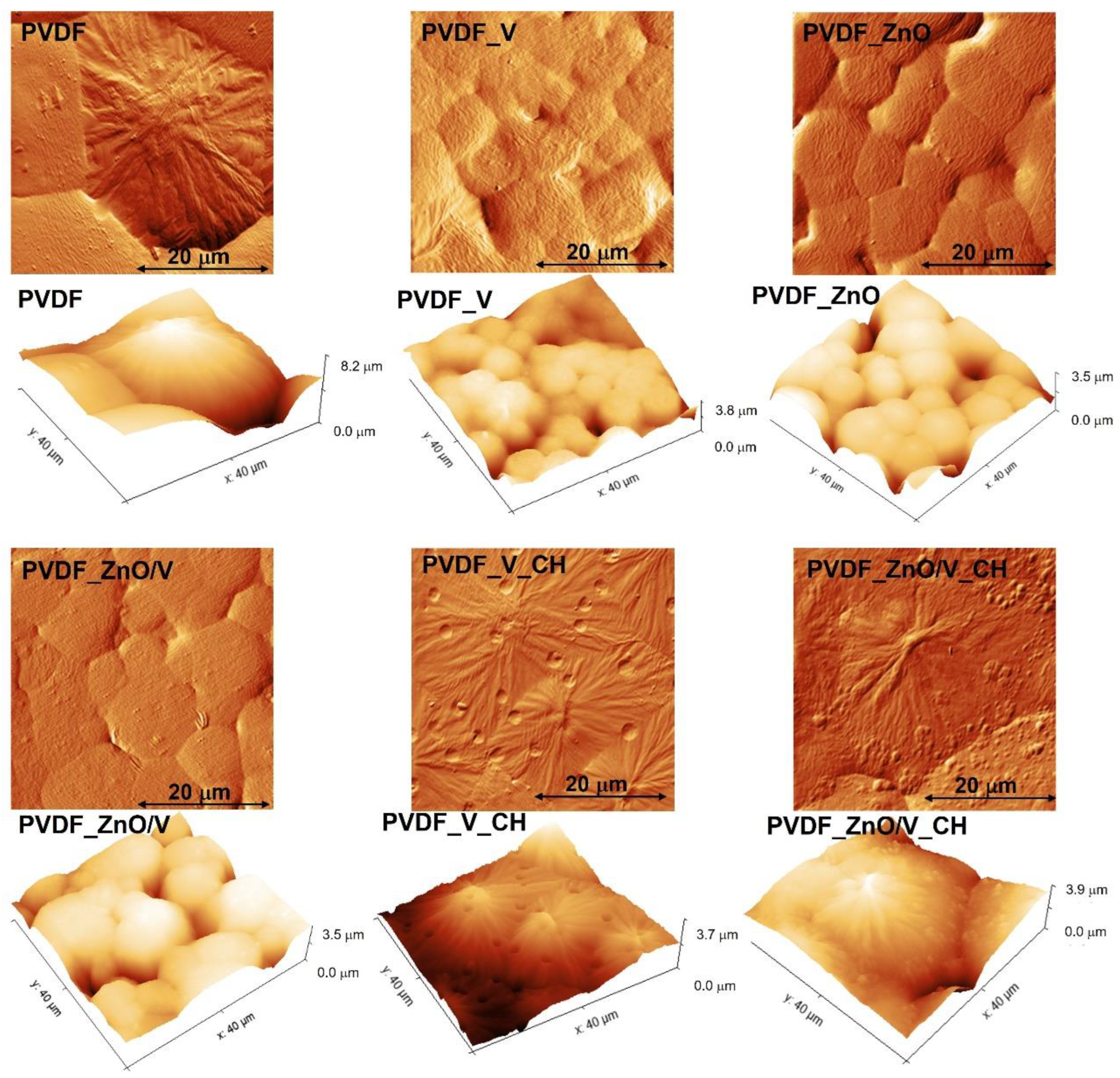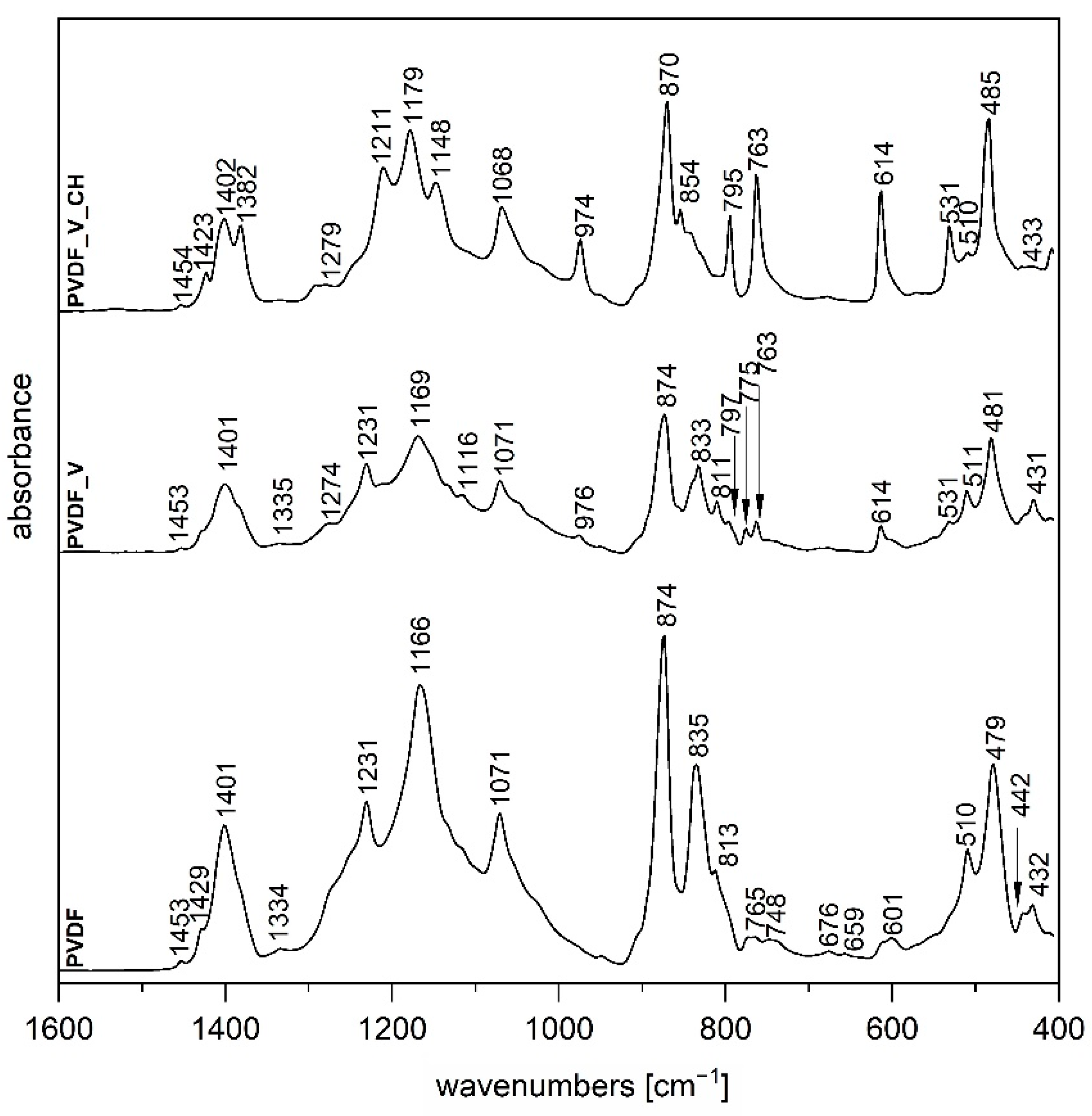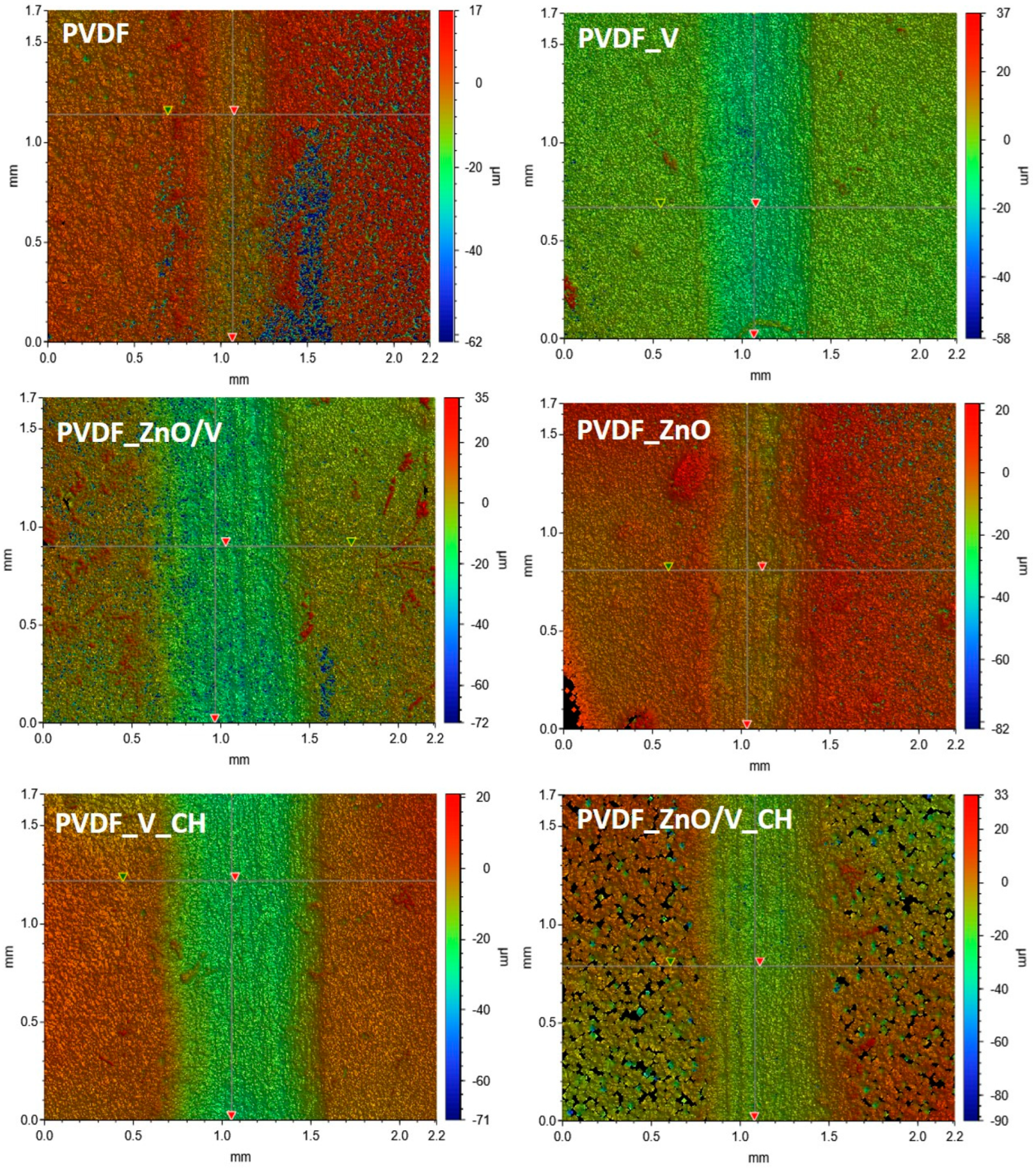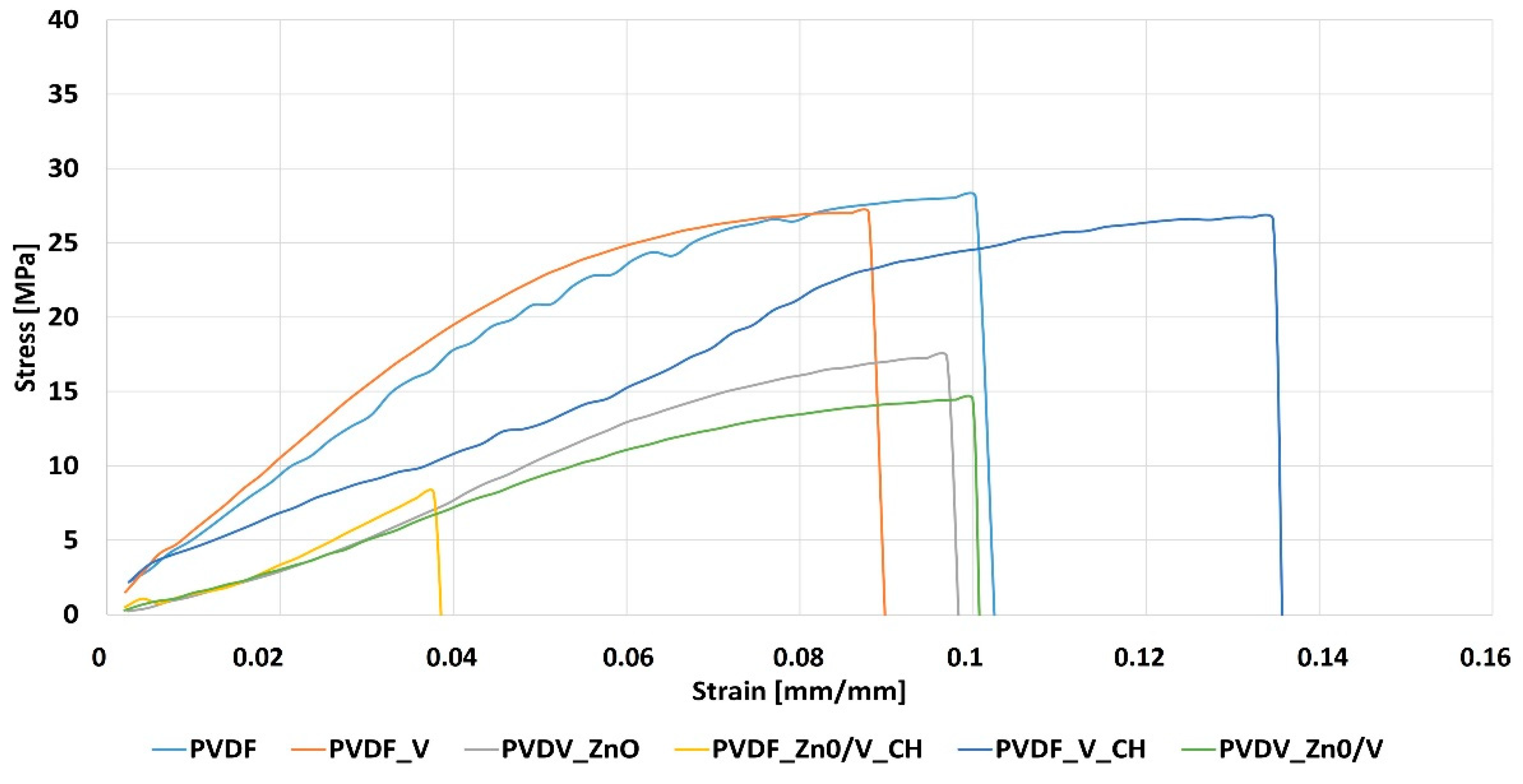3.1. PVDF Nanocomposite Materials Characterization
The PVDF and PVDF nanocomposite films prepared by the ultrasonication assisted solvent casting method with different nanofiller particles were investigated using a scanning electron microscope (SEM) and are show in
Figure 1. Surface morphology and roughness of the PVDF film samples was observed from the top surface of the film samples, i.e., opposite to the surface in contact with the glass substrate (bottom surface).
The original PVDF film was formed by regularly repeating hexagonal and cubic grains with an average size (width and length) of 36.8 μm. White particles were visible on the surface of the spherulitic grains due to the presence of surface impurities (all films were characterized without surface treatment) and pores with an average size of 2.8 μm.
PVDF_V nanocomposite film was formed by spherulitic grains of irregular shapes and sizes in the range of 5.1–10.8 μm. Cavities whose diameter did not exceed 4 μm occurred sporadically between these grains. The vermiculite particles (as a reference filler) were found both in the volume of the PVDF matrix and on the surface of the spherulitic grains and did not exceed an average size of 3.8 μm. Compact spherulitic grains of two sizes, 11.5 μm with a predominant irregular hexagonal shape and 7.5 μm of irregular triangular and hexagonal shape, w characterized in PVDF_ZnO nanocomposite films. The spherulitic grains were close together connected by the edges. There were cavities of non-uniform size in the place of the grain tops. On the surface of PVDF_ZnO nanocomposite films white impurities and scratches caused by handling the polymer film were present. The PVDF_ZnO/V and PVDF_V_CH nanocomposite films consisted of spherulitic grains of two sizes, 13.4 μm and 6.4 μm in the case of PVDF_ZnO/V, and 14.0 μm and 6.9 μm in the case of PVDF_V_CH. There were cavities of different sizes and shapes between the individual grains. The ZnO/V and V_CH nanoparticles were incorporated in the volume of the polymer matrix.
The completely compact (non-porous) PVDF_ZnO/V_CH film was formed by large spherulitic grains with sizes in the range of 18–22.4 μm, at the boundaries of which there were particles of ZnO/V_CH nanofillers with a size of 0.7–1.14 μm. These nanoparticles were predominantly oriented as perpendicular or at an angle of 45° in the polymer matrix.
The topography of PVDF and PVDF nanocomposite films was characterized in detail using correlative imaging (CPEM), combined correlative probe (AFM) and scanning electron microscopy (SEM). In the left part of
Figure 1 is the visible location of the AFM tip. To characterize the topography and roughness of the individual spherulitic grains, areas with a low occurrence of voids were selected. Individual 2-dimensional (2D) scans and 3-dimensional (3D) profiles are shown in
Figure 2.
From 2D CPEM images it is evident that the spherulitic morphologies of the PVDF grains are significantly influenced by the addition of specific nanofillers into the polymer matrix.
The largest spherulitic grains occurred in the PVDF sample with maximum heights at around 8.2 µm, followed by the PVDF_ZnO/V_CH nanocomposite film with heights of 3.9 µm and PVDF_V_CH with heights of 3.7 µm. The highest height differences correspond with the typical lamellae sheets of the PVDF spherulitic grains that produce outwards from their nucleation centres, where morphology is characterized by jammed circular platelets (diameter < 1 μm) and make up the entire volume of PVDF grains.
It should be mentioned that the original PVDF film was formed by two types of spherulitic grains. The first grains (representing a minor part) were formed by regularly branching lamellae sheets, between which lamellae of the dendritic type also appeared in the amorphous region. The second type of grain that predominated in the bulk of the PVDF film were planar spherulite morphologies. Thanks to the presence of these morphologically different grains it was possible to evaluate the differences in the average value of their roughness. While lamellae grains reached a roughness of 52.9 nm (Ra), grains of planar morphology possessed only 27.0 nm (Ra). In the overall context, the roughness of PVDF then reached 31.9 nm (Ra),
Table 2.
The spherulitic grains of the PVDF_ZnO/V_CH nanocomposite film were formed by lamellae morphology with a dendritic crystal on the centre. As can be seen from the image, numerous particles with a size of around 200 nm were randomly distributed on the edges of the spherulitic grains. These particles were the ZnO/V_CH nanofillers on the surface of the PVDF matrix and represented a minor size fraction of these nanofiller.
In contrast to the SEM images, based on the 2D (or 3D) CPEM scan of the PVDF_V_CH nanocomposite film it was found that on the surface of the spherulitic grains there were pores occurred in the polymer matrix with an average size of 6 μm and a depth about 1 μm. These pores emerging irregularly on the surface of the entire PVDF_V_CH sample created the so-called hallo effect in the centre of which there were very fine particles. This structural artefact has not been showed in any of the other polymer films.
The smoothest surfaces of spherulite grains were characterized on the surface of the PVDF_V, PVDF_ZnO and PVDF_ZnO/V nanocomposite films. The grains were hexagonal to spherical in shape, made up of ordered lamellae which are connected by an amorphous region, without voids, cracks and other deformations. Only sporadically, dust particles did occur at the grain boundaries.
Surface roughness values were also characterized using the CPEM scan, which correlate with surface morphology of the PVDF films. These values are significantly affected by many spherulitic grain peaks and voids that appeared in the PCEM images. For this reason, the roughness of the PVDF films was evaluated via the average roughness (Ra, measured by profile/linear analysis) and root mean square roughness (RMS) values (
Table 2). All were obtained from the ten measurements at different locations of the each PVDF films. The roughness with the lowest values of 31.9 nm (Ra) and 43.2 nm (RMS) was measured and evaluated for the natural PVDF film. Nanofillers in the PVDF matrix caused an increase in the roughness values in the range of Ra value from 37.2 nm (for PVDF_ZnO/V_CH sample) to 53.9 nm (for PVDF_V sample). The root means square roughness (RMS) reached higher values than the average roughness values (Ra), while the decreasing character was maintained. The lowest roughness was measured for PVDF film (RMS = 43.2 nm), and the highest values were evaluated for PVDF_V (RMS = 68.0 nm) and PVDF_V_CH (RMS = 59.5 nm) nanocomposite films. With regard to roughness values, the ascending character of these values was recorded in the following order for nanocomposite films: PVDF_ZnO/V < PVDF_ZnO/V_CH < PVDF_ZnO < PVDF_V_CH < PVDF_V. It was found that the change in roughness values does not correlate with lamellar or planar surface topography of the PVDF nanocomposite materials but with the size of the specific surface area of the individual nanofillers. It can be stated that the roughness of polymer nanocomposite films decreases with the decreasing value of the specific surface area of nanofillers.
The surface wettability of the PVDF samples was evaluated from the water contact angles (
Table 2). The WCA values confirmed the wettable (hydrophilic) surface of all PVDF samples when the lowest WCA value measured for the original PVDF film was 43°. The nanofillers in the PVDF matrix preserved the hydrophilic nature of the nanocomposite films but caused an increase in WCA values in the range of 58°–69°. The WCA values are in good agreement with not only the surface roughness but also surface morphology and topography. The fact that a minor part of the nanofillers in the PVDF_ZnO/V_CH, PVDF_ZnO/V and PVDF_V nanocomposite films was located on the surface of the spherulitic grains had a non-negligible effect on the lower WCA values. It is known that vermiculite particles (V) as part of nanofillers are characterized by a high adsorption capacity and a large surface area (see
Table 1) [
18], and therefore it can be assumed that they adsorbed water molecules into their interlayer space during the measurement. The lower hydrophilicity of PVDF nanocomposite materials also contributes to the numerous presences of voids located between individual PVDF spherulitic grains. Overall, PVDF nanocomposite films are moderately hydrophilic.
Table 3 presents Zeta-potential values for individual samples. The left column presents values for nanofiller particles (ζ
n) and the right column values for PVDF nanocomposite films with these nanofillers. The Zeta-potentials of nanoparticles ζ
n vary significantly, especially when nanoparticles are covered with chlorohexidine (CH). It changes to the positive values due to a presence of amino and imino groups in chlorohexidine molecules which causes the positive surface charge [
19]. The values for PVDF nanocomposite films show the similar trend. The original PVDF film is negatively charged due to presence of fluorine in its structure. Zeta-potential of PVDF nanocomposite films with individual nanoparticles changes according to the Zeta-potential of used nanofillers. When nanofillers are covered with chlorohexidine, Zeta-potential of PVDF changed significantly to the lower negative value (in comparison with original PVDF) due to the presence of amino and imino groups. This change is more significant for ZnO/V_CH in comparison with only V_CH the same as the ZnO/V_CH particles have much positive Zeta-potential. Due to less negative (for ZnO and ZnO/V) or even positive (for V_CH and ZnO/V_CH) surface charge of used nanoparticles it is expected to create strong electrostatic interactions between used nanoparticles and PVDF with a strongly negative surface charge. Due to this it is expected for preparation of stable PVDF nanocomposite films. It is confirmed by very small standard deviation of Zeta-potential during measurement of individual samples (samples are wetted by electrolyte under pressure).
3.2. Fourier Transform Infrared Spectroscopy
The FTIR technique is a very useful tool providing us with information about the structure of semi-crystalline polymer PVDF which exists in three basic distinct polymorphs and allows us to distinguish between them [
20,
21]. The FTIR spectrum of the original PVDF film (
Figure 3 and
Figure 4) shows typical bands for γ-phase at 1429, 1231 and 835 and 510 cm
−1 attributed to CH
2 bending, C-F out-of-plane deformation and CH
2 rocking vibrations, respectively [
21]. In the case of spectra of PVDF_ZnO and PVDF_ZnO/V nanocomposite film (
Figure 4) we can observe almost the same vibrations as for original PVDF film which indicates that both nanofillers did not change PVDF polymorph type.
A different situation occurs in the case of FTIR spectrum for PVDF_V nanocomposite film (
Figure 3). Except predominant γ-phase in this sample the addition of V nanofiller led to the formation of small amount of α-phase for which following vibrations are typical: 1211, 976, 797, 763, 614 and 531 cm
−1 which belong to CH
2 bending, C-H out-of-plane deformation, CH
2 rocking, CF
2 bending and sceletal bending, respectively [
21].
The presence of organic component chlorhexidine CH in nanofillers caused formation of α-phase, when FTIR spectrum for PVDF_V_CH (
Figure 3) confirmed creation solely of this polymorph, on the other hand on combination with ZnO in sample PVDF_ZnO/V_CH FTIR spectrum (
Figure 4) showed a mixture of α and γ phases.
It can be assumed that hydroxy groups of vermiculite, as well as amino and imino groups of chlorhexidine through negatively charged PVDF due to the presence of fluorine, cause transformation of PVDF phases from polar γ to non-polar α, but on the contrary, the presence of ZnO inhibits this process. These findings agree with values of Zeta-potentials ζ
n for above mentioned nanofillers (
Table 3).
3.3. Friction and Mechanical Properties of the PVDF Nanocomposite Films
The friction/tribological properties of the PVDF samples were evaluated by static wear tests performed against steel balls by the ball-on-flat method. The testing conditions (1N for 5 min.) were chosen with regard to the simulation of normal intensively loading and wear of the polymer film.
Table 4 summarizes the friction coefficients (COF, average values measured during the test based on four repetitions of each test, with the minimum standard deviations ±0.05) and abrasion depths (AD, standard deviations ±0.3 µm). The representative friction/tribological plots are shown in
Figure 5 and profilometry images are shown in
Figure 6 of PVDF and PVDF nanocomposite films.
From the friction/tribological plots (
Figure 5) it is evident that each of the PVDF samples achieves frictional stability (a steady value and smooth polymer surface) after different times of the friction load. While in the case of the PVDF_ZnO/V_CH and PVDF_V_CH nanocomposite films stability is achieved after 15 s, for the PVDF_ZnO and PVDF_V samples it is 25 s. The tribological plots of the original PVDF and PVDF_ZnO/V nanocomposite film continuously increased up to 60 s PVDF samples and reached a steady COF value after 70 s. The COF values measured at the end of the measuring time are shown in
Table 4.
The COF values of the PVDF nanocomposite films were in the range (in terms of average values) of 0.79 to 1.07, compared to the original PVDF film with value 0.91. Only the PVDF_V sample showed an increase in the COF value, while the COF value decreased slightly for the other PVDF nanocomposite films. It can be assumed that the vermiculite particles (V) in the PVDF matrix, due to their horizontal orientation, contribute to the increase in COF values. Similar changes in COF values were also observed in [
22]. However, the values of abrasion depths (AD) and abrasion track width (ATW), which are shown in
Table 4, have more description about resistance of the nanocomposite material against frictional action.
The smallest penetration of the steel ball into the polymer materials and therefore the highest resistance of the material against damage/abrasion occurred in the PVDF and PVDF_ZnO samples, when the values of abrasion depths (AD) reached the lowest values of 4.6 and 6.1 µm. On the contrary, the largest penetration was measured for the PVDF_V_CH nanocomposite material, namely 20.7 µm (AD). Other values of abrasion depths (AD) ranged from 12.1 to 16.6 µm. The abrasion track width (ATW) values also correspond to these values. The AD and ATW values indicate that the PVDF and PVDF_ZnO nanocomposite plates exhibited better wear resistance.
Figure 6 shows the representative optical images of the polymer material surfaces after friction/tribological tests, and the points that were used to evaluate the abrasion depths values (AD) are also marked. It can be seen that in all polymer samples a smooth sliding plane was formed at the point of contact and frictional movement of the steel ball. The PVDF and PVDF_ZnO nanocomposite films showed visible migration of the PVDF matrix and the formation of a polymer edge. This is most evident in the PVDF_ZnO nanocomposite film, where polymer craters with an average size of 10 μm are visible on the edges. In the case of the PVDF sample, the formation of structural defects in the form of holes are visible (blue area visible in the image), which were also visible to a lesser extent in the case of the PVDF_ZnO/V nanocomposite film.
The most visible change in the structure after the friction test was for the PVDF_ZnO/V_CH nanocomposite film. The originally compact structure without visible cavities was formed by parts of mutually separated spherulitic grains, resulting in the most porous material of all the studied samples. The PVDF_ZnO/V_CH nanocomposite film shows the lowest Zeta-potential values (−16.6 mV) of all samples, which is a prerequisite for the least stable nanocomposite film. At the same time, as the only nanocomposite film, it had visible fractions of nanofillers occurring at the boundaries of the spherulitic grains. It can be assumed that the acting frictional movement is so intensive that it causes disruption of the bonds between the spherulitic grains and therefore to the total destruction and structural changes in the PVDF_ZnO/V_CH nanocomposite film. However, it is evident that during the friction test a smooth sliding plane occurs at the point of contact of the steel ball with the surface, as is the case with other PVDF nanocomposite films. This fact is confirmed by average AD and ATW friction values in PVDF_ZnO/V_CH nanocomposite film.
The least friction-resistant material was the PVDF_V_CH nanocomposite film, which reached the highest AD and ATW values. Here it can be assumed that the V_CH nanofiller created a friction layer that allowed the steel ball to move smoothly over the tested polymer surface without structurally disrupting the PVDF_V_CH nanocomposite film. Similar behavior can be assumed for the PVDF_V nanocomposite material, however, there is not such a deep penetration of the steel ball into the material, which is declared by the AD and ATW values and at the same time the highest COF value.
The mechanical properties of the PVDF nanocomposite films were evaluated based on the tensile tests. The results of the tests carried out are presented in
Table 5 and the tensile test curves are shown in
Figure 7. On the basis of the obtained test results, the following parameters were calculated: Young’s modulus (E), tensile strength (Rm), maximum force (Fmax) and maximum strain (Smax).
When analysing the obtained test results, it was noticed that the highest tensile strength values were obtained for PVDF (Rm = 28 MPa) [
23] and the lowest for PVDF_ZnO/V_CH (6 MPa) nanocomposite films. In the case of PVDF_V, PVDF_ZnO, PVDF_ZnO/V, PVDF_V_CH nanocomposite films, the obtained values were similar and ranged in value 13–19 MPa. The PVDF_V nanocomposite film was characterized by the highest stiffness (E = 568 MPa), and thus the greatest Young modulus, while the greatest flexibility was demonstrated by the PVDF_ZnO/V and PVDF_ZnO/V_CH nanocomposite films with the 213 MPa, 214 MPa, respectively.
From the tensile stress–strain curves of the PVDF and PVDF nanocomposite films (
Figure 7) it is evident that the most susceptible to deformation turned out PVDF_ZnO/V nanocomposite film with the Smax = 0.985 mm.mm
−1 compared with original PVDF [
23], which was characterized by the lowest deformation Smax = 0.065 mm.mm
−1. In the case of other materials, the obtained differences were not so significant. As for the breaking strength (Fmax), the highest value was recorded for PVDF_V (52 N), while the lowest for PVDF_ZnO/V_CH (8.5 N). The original PVDF and PVDF_V_CH nanocomposite film had the same breaking strength value of 41 N.
The mechanical test values of the PVDF nanocomposite films were compared with mechanical test results obtained for the PVDF nanofibers material with identical nanofillers [
24]. The decrease in the Young’s modulus (E) was observed for the PVDF, PVDF_ZnO, PVDF_ZnO/V and PVDF_ZnO/V_CH nanocomposite films. The percentage decrease in these values was determined, which for individual materials was as follows: PVDF (−22%), PVDF_ZnO (−27%), PVDF_ZnO/V (−43%), PVDF_ZnO/V_CH (−31%). Only in the case of the PVDF_V_CH nanocomposite film was an increase in the value of Young’s modulus noted, by 14%. In the case of the maximum breaking stress Rm, a decrease of an average of 68% was recorded for all materials. The largest decrease (Rm) was recorded for the PVDF_ZnO/V_CH nanocomposite film, which was 88%. The obtained research results were compared with the results of other authors [
23,
25]. The value of deformations and maximum stresses was obtained at a similar level.















